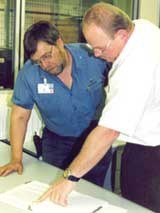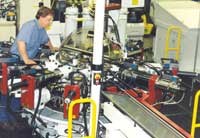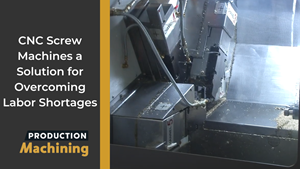Increasing The Value Of Your Most Important Asset
Investing in employee training pays big dividends at this Chicago area screw machine shop.
Ask most companies why they don’t train their machine operators and you’ll probably hear, “Why should we invest a lot of money training employees who will leave the first time someone offers them 25 cents an hour more?” Or, “We can’t afford something like that, especially now with business so slow.”
Some firms, however, regard employee training as a wise investment—one that not only ensures them a continuous supply of skilled workers but also pays dividends by reducing or eliminating situations where costly mistakes can be made by employees who do not know any better. One such firm is Camcraft (Hanover Park, Illinois), a precision machined parts producer.
Camcraft began an in-house training program about 6 years ago. “From a practical standpoint, we train to assure ourselves of a constant supply of qualified operators and supervisors,” explains Don Slawinski, training facilitator for the company. “Also, Camcraft’s mission statement commits the company to help its employees realize their full potential on the job and in their personal lives, and the training program helps us achieve that goal.”
That the company takes its training seriously is evident from a separate two-room training facility located on a mezzanine level off the plant floor. The outer room is large and can accommodate a number of trainees for group lessons. The inner room, separated from the outer by a window wall, is a computer lab, equipped with six PC workstations, each with its own software, set up for individual multimedia training.
One of the major advantages of having the training area off the plant floor is the freedom from distractions. “When a machine tool builder or distributor comes in to provide training for a newly installed machine, there’s so much distraction on the plant floor that it’s easy to miss some important information,” notes Mr. Slawinski. “Then, too, the training is specific to the machine. That’s fine if the operator stays with that machine. However, we expect our operators to be able to run several different machines, which may be equipped with different controls. For that reason, we feel that it is more important for our people to be taught more general knowledge that they can apply to run any of our machines.”
An important part of setting up the training facility was deciding what kind of training materials to use. As Mr. Slawinski thought about the training materials he needed to develop a formal apprentice training program at Camcraft, one concern was uppermost: He wanted a program that would enable him to know for certain that students were learning the material. The program had to provide a solid foundation of basic knowledge that trainees would be able to apply to specific situations, and it had to be comprehensive enough to cover all operations performed at the company.
After evaluating the training materials that were appropriate to Camcraft’s situation, he chose several programs from MasterTask Training Systems (Rockford, Illinois), a division of V-TIP, Inc. MasterTask is a multimedia training system that uses workbooks, videos, CD-ROMs and the Internet to train both new and experienced employees in machine tool operations, setups, programming and related topics. The company offers courses on CNC turning centers, machining centers, automatic screw machines, precision measurement for machinists, SPC and other manufacturing-related subjects.
Training proceeds from general principles to their application on specific machines. For example, in the Mastering CNC Lathes course, once a job task or CNC concept is introduced, the lesson shows how it is applied on machines equipped with the most common CNCs. This approach is designed to give trainees the understanding needed to operate any CNC lathe in the shop, regardless of the make of the control. Of course, instructors will use only those materials that cover the CNCs in the shop.
The Mastering CNC Lathes series includes five separate courses: The Basic CNC Lathe, Understanding Part Programs, Lathe Operator Skills, Basic Setup Skills and Advanced Setup Skills. Training materials for the series include 21 videocassette lessons, five CD-ROMs with 21 interactive tests, five instructor guides, five student guides and 21 lesson worksheets.
Perfect Score
MasterTask can be used for group or individual training and is designed to allow the trainee to learn at his or her own pace. An appealing feature of the system—certainly one that appealed to Camcraft’s Mr. Slawinski—is that the trainee must master all of the information presented in each lesson before proceeding on to the next. That’s where the testing comes in: The trainee must score 100 percent on each lesson test before advancing to the next lesson and must retest on the missed questions until everything is right.
Now, you may be thinking back to your school days and remembering that you never scored 100 percent on a test! The tests you remember were designed to produce a few perfect scores, a few failures and lots of Cs. According to MasterTask, their tests are different. Most trainees find it relatively easy to get perfect scores, and early successes encourage and motivate them to continue the learning process. When you think about it, do you want the operator of your million-dollar rotary transfer machine to have answered all of the questions correctly, or is it OK if the operator got a few questions—that just might bear on the proper operation of your machine—wrong?
Mr. Slawinski teaches about 30 different classes at Camcraft, including the Mastering CNC Lathes and Mastering CNC Machining Centers programs as well as MasterTask courses for Camcraft’s New Britain and Davenport automatic multi-spindle screw machines and Brown & Sharpe single-spindle automatics. When Camcraft inaugurated a formal, in-house training program 6 years ago, it put its experienced workers through the apprenticeship training program first. “When you have an experienced machinist, you tend to assume that he knows everything there is to know about certain areas of machining,” Mr. Slawinski notes. “Such assumptions are frequently wrong. Retraining our experienced workers not only improved their performance, but it also better equipped them to mentor the younger people coming up through the system.”
Core Classes
Of the 30 or so classes Mr. Slawinski teaches at Camcraft, eight are designated core requirement classes that everyone in the company—receptionists, maintenance people, management . . . everyone—is required to take. The courses, in metrology, blueprint reading, QS9000, and so forth, are introductory in nature rather than technical and are intended to familiarize all employees with the issues and concerns that the company must deal with every day. The core classes are mandatory for all new hires, even part-time help.
A Path To Advancement
The training program is not a one-way street with all of the benefits going to the company. The employees also benefit from the program in very tangible ways. At Camcraft, all direct labor employees have job rankings, starting with Level 1 for basic machine operators to Level 7 for specialists. Every employee is encouraged—expected—to participate in the training program.
Every employee receives recognition for participating in the program. For example, when an employee completes the 8 core classes, the person receives a certificate acknowledging the achievement and is honored at the company’s next quarterly meeting.
All Camcraft employees wear ID badges that not only identify them by name but also the amount of training that they have received. For example, the badges of employees that have passed the core requirements classes bear a scroll icon. As the employee continues through the training program to become a journeyman machinist, the person’s badge is updated accordingly. When the employee successfully completes the classes for National Institute of Metalworking Skills (NIMS) certification—Camcraft is an accredited NIMS training facility—the person’s badge proclaims the accomplishment. The amount of training that the employee has received is right there on the person’s ID badge for everyone to see.
Also, if an employee successfully completes the classes for NIMS certification, he or she receives a leather jacket from the company with Camcraft and NIMS emblems on the sleeve. The jackets are presented only to journeyman machinists at Camcraft who have gone on to achieve NIMS certification—one more way that the company rewards its employees for their training accomplishments.
At Camcraft, advancement depends on what you know, not who you know, and the company provides both incentive and opportunity to learn. Attaining one level enables the employee to train for the next level and move up the ladder to increasingly responsible positions. There are also monetary rewards along the way. On completion of training for the next level, employees involved in the apprenticeship program receive a $500 cash award and may qualify for a raise.
Stepped-Up Training
Mr. Slawinski observes that many metalworking firms have shut down their training programs in the last few years in response to the downturn in the economy. He feels they have shot themselves in the foot by doing so. “Although we’ve also been affected by the downturn, we’ve stepped up our training program to be in an even better competitive position when the turnaround starts,” Mr. Slawinski notes. “Instead of just hoping that we’ll survive, we’re taking the steps needed to ensure our survival. Training an efficient, knowledgeable and motivated workforce is an important part of that effort. We didn’t cut our employees’ hours; instead, we put them in class.”
One of the most important offerings is the CNC training program, which incorporates MasterTask’s Mastering CNC Lathes and Mastering CNC Machining Centers programs. All of Camcraft’s experienced machine operators and setup people must take the course as well as all new hires. As time goes on the course becomes more and more pertinent: “When we moved to our new facility 9 years ago, we had seven or eight CNC machine tools,” Mr. Slawinski recalls. “Today, as a result of our ongoing equipment modernization program, we have 68 CNC machine tools, with 13 different CNCs. As time goes on, we’ll be acquiring more and more CNC machines.
“We cross train extensively, and we require our operators to be able to move from one CNC machine with one type of control to another CNC machine with another type of control,” Mr. Slawinski continues. “For that reason, we prefer our operators to have a solid foundation in CNC—M codes, G codes, the language of CNC. With that knowledge they can go from one machine to another instead of being limited to one machine and one type of control. For example, three or four of the employees who have taken the CNC course are from our CNC Swiss screw machine department. They had little difficulty applying the basic principles they learned in training to specific machines such as our Citizen CNC Swiss machines. A person who has a good general knowledge of CNC is more valuable to us than someone who knows only one kind of machine or control. ”
Last year, ten employees completed the CNC program, and two of them went on to obtain NIMS certification. This year, four employees are taking the course. Each receives about 2 hours of training on company time per week. The course can run from 12 to 18 months, depending on the experience of the trainee.
Mr. Slawinski has worked with 12 trainees in the New Britain multi-spindle automatic apprenticeship program in the last 2 years, ten of whom went on to receive NIMS certification. He currently has six students taking the New Britain course and two trainees in the Davenport multi-spindle automatic program.
Since 1996, Camcraft has provided about 29,000 hours of training to new and existing employees. Although the training program at Camcraft has declined in terms of the number of employees taking courses—most have already taken them—there is no sense that the training task is finished. “In the next 10 to 15 years, about 50 percent of our present workforce will reach retirement age,” Mr. Slawinski stresses. “We need to train our young people so that they can take the place of those retiring workers. In most cases, tomorrow’s work force will need more training than the people they replace because the machines and manufacturing processes they will be involved with will be considerably more complex, more sophisticated . . . and more expensive.”
How has all of that training benefited Camcraft’s bottom line? Mr. Slawinski concedes that it is difficult to attribute performance improvements such as fewer rejects, fewer crashes, less tool breakage and so forth, to training alone. Also, the benefits from training are cumulative rather than immediate. That said, he points out that when the training program started at Camcraft in 1996, the cost of quality, which includes scrap, rework, returns from customers and so on, was about 5 percent of sales. After 29,000 hours of training of both existing employees and new hires, Camcraft’s cost of quality has dropped dramatically (see graph). The projected cost of quality for 2003 is a modest 1.2 percent of sales—or a 76 percent reduction compared to pre-1996 levels. Mr. Slawinski also reports fewer crashes and less downtime for the machine tools.
Patrick Bertsche, vice president of operations for Camcraft, adds that in the last several years the company’s productivity has increased 30 to 40 percent. He attributes at least 10 of those percentage points to the company’s training program. “Our employee turnover is much lower as a result of our training program,” he adds. “Our system enables me as plant manager to have confidence in the people who are running the jobs, and that’s a huge consideration. Now, not everyone is interested in training; some people don’t want to be pushed, don’t want to be challenged. They move on before very long. Those who stay want to grow, want to develop, and we want them to succeed.
“The training program is good for Camcraft, because we can be sure that we have good people,” he continues. “It’s also good for our employees because it gives them real opportunities to improve. They can see growth. They can see that if they learn these skills, they can move up in the ranks and make more money. In fact, the training program helps us attract the kind of employees we’re looking for. The program tells them that we’re genuinely interested in helping them develop skills that can help them have a better tomorrow.”
Related Content
Video Tech Brief: CNC Screw Machines a Solution for Overcoming Labor Shortages
CNC screw machines can exceed job shop productivity and enable manufacturers to overcome perpetual employment gaps.
Read MoreGift a 3D Printer to an Employee?
Some shops have purchased inexpensive polymer 3D printers for their operations. Does it make sense to take this a step further and give (or loan) a sharp young employee one to experiment with at home? This small investment could pay off for your shop in different ways.
Read MoreStrengthening Manufacturing Workplaces Through Active Listening
A good strategy to weather the storms of manufacturing market upheavals and unpredictable factors is to commit to continuous, active employee listening.
Read MoreThe Value of Aligning Efforts to Promote Manufacturing Careers
Successfully building the next generation of manufacturers requires a team effort between employers, educators and parents. Each of these three groups has a tremendous impact on young people’s career decisions. Without the support of all three, we are unlikely to bridge the skilled labor shortage that threatens the future growth of our industry.
Read MoreRead Next
A Tooling Workshop Worth a Visit
Marubeni Citizen-Cincom’s tooling and accessory workshop offers a chance to learn more about ancillary devices that can boost machining efficiency and capability.
Read More5 Aspects of PMTS I Appreciate
The three-day edition of the 2025 Precision Machining Technology Show kicks off at the start of April. I’ll be there, and here are some reasons why.
Read MoreSeeing Automated Workpiece Measurement in Real Time
User-friendly inspection software for CNC machining centers was shown at IMTS 2024 monitoring measurements between and after machining while performing SPC based on recorded measurement values.
Read More














.jpg;maxWidth=300;quality=90)









